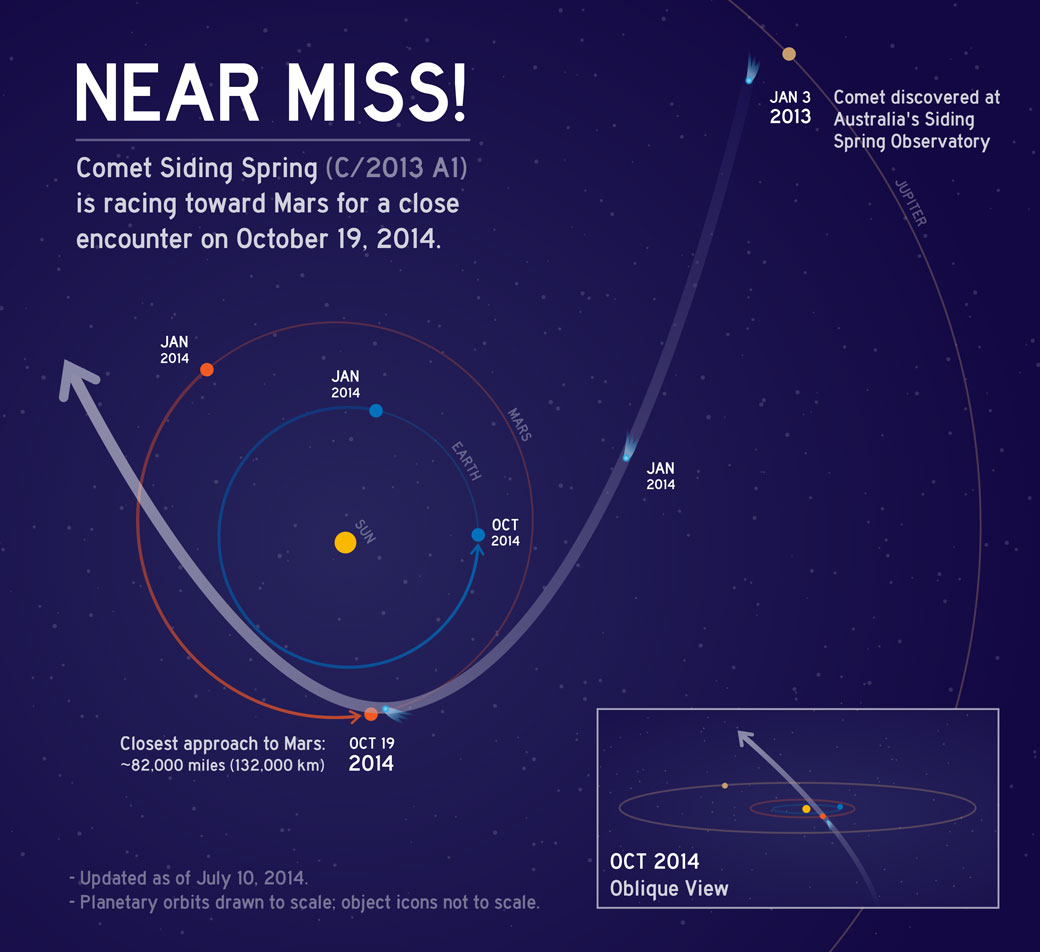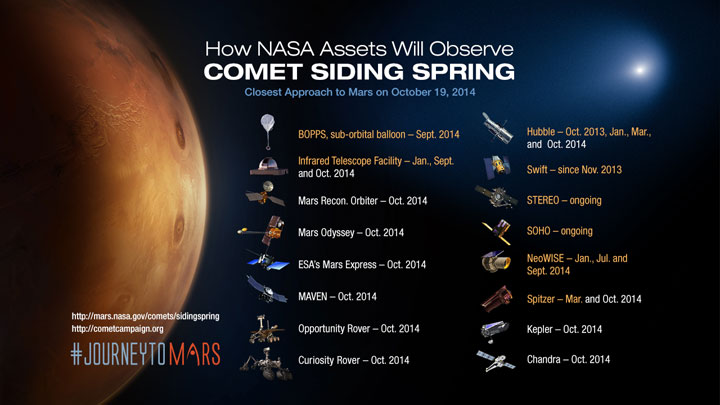Watch the video above: NASA prepares for comet’s close encounter with Mars.

TORONTO – It’s a close encounter of the Mars kind.
On Oct. 19, Comet C/2013 A1 — also known as Comet Siding Spring — will make an extremely close pass of Mars, coming within 139,500 km of the planet’s surface. That’s less than half the distance between Earth and our moon.
Here are five interesting things about the impending flyby you probably don’t know.
1. Not going to be that bright
Though the flyby is very close, so far photographs show that the comet isn’t anything spectacular. So don’t expect a “comet of the century” kind of build-up.
As the comet nears perihelion — its closest approach to the sun — the tail is expected to brighten somewhat. However, so far, the comet isn’t anything to talk about. In fact, it’s dimmed somewhat over the past week. The problem with trying to anticipate what a previously unseen comet will do is that, well, it’s never been seen before. According to comet expert Karl Battams’s latest blog, anything could happen (remember Comet ISON?): it could brighten, it could fade or it could fall apart altogether. Only time will tell.
“There’s always that saying that keeps getting used over and over again,” said Kelly Fast, program specialist at NASA’s headquarters. “Comets and cats are both alike: they both have tails and they do whatever they want.”
If it does hold together, Canada is not in the prime viewing location for the comet. By the time skies darken, Mars will be below the horizon. So the place to be is the southern hemisphere. Even then, you’ll need binoculars or a small telescope.
2. How C/2013 A1 got its name
Comet C/2013 A1 was first discovered by Robert H. McNaught, a prolific comet discoverer. To date , McNaught has discovered and co-discovered 82 comets.
McNaught discovered the comet using a telescope at the Siding Spring Observatory in Australia.
The comet gets its name from the observatory where it was discovered (there are several Comet Siding Springs).
But the standard for naming comets comes from the International Astronomical Union (the same people who demoted Pluto from its planetary status).
Each of the 12 months is divided into two parts for each month, so January is A and B, February is C and D and so on. In the case for Comet C/2013 A1, the C stands for the type of comet (non-periodic, meaning that it has only been observed once in its passage around the sun); 2013 is the year it was discovered; A stands for the month it was discovered (first-half of January) and the 1 is the order of discovery within that half month.
3. Mars rovers get the best view
The best place to see the comet’s close approach is Mars, of course. That means that the rovers on the planet’s surface — Opportunity and Curiosity — will be our eyes.
The planet will pass through the comet’s dust tail, and some particles are expected to enter the thin atmosphere. Though the location of the rovers won’t necessarily see a meteor shower, it will be interesting to see what they see.
“It’s not ideal for them in terms of the time of day and the fact that it’s the dusty season,” said Fast.
Still, that’s not bad news. Nobody wants to see any of the rovers impacted or covered in dust (Opportunity relies on solar power).
“Mars is going to be on the edge of that dust cloud. So there might not be a whole lot of dust reaching the atmosphere or the spacecraft, thankfully,” she added.
4. NASA plans to study it using multiple spacecraft
There are a lot of spacecraft orbiting Mars, including NASA’s most recent, MAVEN, as well as India’s Mars Orbiter Mission. Scientists and engineers have already been busy preparing the spacecraft for the encounter.
The period of greatest risk, NASA said, will start about 90 minutes after the comet’s closest approach. It will last for 20 minutes when Mars gets closest to the centre of the trail of cometary dust.
But there are a multitude of space-based satellites that will be taking advantage of the opportunity to study a comet in-depth without the cost of sending a mission to one (though there is currently the Rosetta mission which is doing just that).
Fast said that one of the fascinating things is being able to see if the comet deposits water into the upper atmosphere. And the MAVEN spacecraft now orbiting is there to study the atmosphere, so scientists are excited.
“They’re going to see if they can detect any changes to Mars because of that comet flyby, but they’re also going to study the comet itself. It’s like getting free comet missions,” Fast said.
“It’s from the outer solar system, so it’s an Oort Cloud comet. It’s a first time visit in our solar system, so it represents that leftover material from the formation of the solar system, so it allows us to study that sort of material. But also that it’s coming so close to the planet…this might be the only time in our lifetime that we see something like this.”
5. Not going to impact Mars
When the comet was first discovered, it was believed that it would impact Mars. Though it would have been a spectacular display, it wouldn’t have been without its hazards: any rock or debris that may have blasted out into space could have posed a danger to Earth. It could have been possible for the debris to travel to Earth or for Earth to pass through some large pieces of Mars.
Fortunately, after months of observations, scientists determined that the comet would be merely grazing the Red Planet. So there’s no fear of an impact on Mars.
Interestingly, the first — and last time — we saw a comet impact a planet was in 1994 when Comet Shoemaker-Levy 9 slammed into Jupiter. The comet had been torn apart during a previous pass of the giant gas planet, leaving a string of more than 20 pieces.





Comments